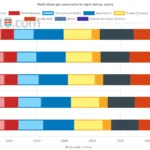The Foundation for Defence of Democracies (FDD), a prominent think tank and registered lobbying organization based in Washington, D.C., has partnered with the Taiwan Academy of Banking and Finance (TABF) to conduct strategic war games focused on potential scenarios involving China’s pursuit of reunification with Taiwan. Both organizations have raised serious concerns over the preparedness of Taiwan and the United States to counter a campaign of cyber-enabled economic coercion from China.
The memo released 10/04 explain the war games that took place back in august, structured as a tabletop exercise (TTX), simulate a possible future where China orchestrates a comprehensive strategy—combining economic pressure, cyberattacks, and limited military maneuvers—to weaken Taiwan’s resilience and extract political concessions. The goal of the joint effort was to identify vulnerabilities and devise effective counter-strategies that can bolster Taiwan’s defences against such aggressive tactics.
The Hypothetical Strategies China Could Employ
🚶♂️ “The Long Walk”
A slow-burning campaign of economic coercion, designed to exhaust Taiwan’s resilience and internal cohesion through a protracted, incremental approach, rather than a swift and overt military strike. Drawing inspiration not from: “Take a long walk off a short pier” but from the Chinese Communist Party’s historic Long March—a harrowing retreat during the Chinese Civil War that ultimately enabled the CCP to regroup and triumph—described by analysts as a “multi-year siege in the shadows,” avoids crossing the threshold of outright military conflict. By remaining beneath the radar of traditional warfare, China could effectively sidestep triggering direct military intervention from Taiwan’s allies, particularly the United States, while simultaneously avoiding severe international condemnation.
- Trade Manipulation: As Taiwan’s largest trading partner, China could disrupt key Taiwanese industries by imposing tariffs, bans, or other barriers on exports from critical sectors such as agriculture, textiles, and chemicals. China could also restrict imports from Taiwan, generating shortages and economic stress. This tactic, if sustained, could erode Taiwan’s economic stability over time.
- Lawfare: Legal warfare might be deployed against Taiwanese businesses and individuals. China could manufacture charges—such as tax evasion or environmental violations—against high-profile business figures, leading to asset freezes or operational disruptions. Such targeted legal actions could create an atmosphere of uncertainty and deter future investments in Taiwan.
- Bureaucratic Obstruction: By weaponizing its bureaucracy, China could impose burdensome regulations and delays on Taiwanese businesses operating within its borders. This might include delaying remittances, restricting capital transfers, and complicating efforts by Taiwanese firms to close operations in China. These bureaucratic roadblocks could serve to frustrate business operations and gradually erode Taiwan’s economic viability.
- Market Manipulation: China could leverage its financial influence to destabilize Taiwan’s economy. Through state-owned enterprises or proxies, Beijing could engage in short-selling of Taiwanese stocks, spread disinformation to provoke panic selling, or pressure credit rating agencies to downgrade Taiwanese companies. By undermining confidence in Taiwan’s financial markets, China could foster economic instability without engaging in direct confrontation.
- Elite Capture: China may also seek to sway Taiwanese public opinion by co-opting influential business leaders, politicians, and cultural figures. Offering financial incentives or applying subtle pressure, China could encourage these elites to advocate for pro-China policies or promote narratives that weaken Taiwan’s resistance. This tactic could drive internal divisions within Taiwanese society, fostering a sense of inevitability about reunification.
The effectiveness of “The Long Walk” lies in the cumulative impact of these tactics over time. Rather than seeking immediate capitulation, China aims to gradually undermine Taiwan’s confidence, weaken its societal cohesion, and pressure its leadership into accepting reunification on Beijing’s terms. The long-term nature of this strategy makes it particularly difficult to counter, as each individual action may appear minor but, when combined, could be devastating. Analysts also express concern that the United States currently lacks the necessary tools to effectively counter such a campaign.
👻 “Ghost in the Machine”
A rapid and intense campaign of cyber-enabled economic warfare, with the goal of crippling Taiwan’s critical infrastructure and plunging its society into chaos. By targeting essential functions, this approach would seek to instill fear and paralysis, hoping to compel Taiwan’s leadership into swift capitulation before international allies have time to respond effectively.
- Cyberattacks on Critical Infrastructure: China could launch debilitating strikes against Taiwan’s energy grid, causing widespread blackouts and halting industrial output. Taiwan’s energy infrastructure, particularly its reliance on imported liquefied natural gas (LNG) and its centralized power grid, is considered especially vulnerable. Targeting key nodes in the grid could trigger cascading failures, leading to long-term outages and exacerbating public panic.
- Disruption of Financial Systems: The strategy could include cyberattacks aimed at Taiwan’s financial institutions, undermining public trust and destabilizing the economy. Disrupting interbank transfers, disabling online banking systems, and stealing or manipulating sensitive financial data could lead to widespread fear of bank collapses. Disinformation about cyber breaches or financial instability could compound these effects, sparking bank runs, capital flight, and a collapse in investor confidence.
- Severing Undersea Cables: Taiwan’s dependence on undersea cables for internet and communications connectivity makes it especially vulnerable to physical sabotage. China could sever or disrupt these cables using underwater drones or covert operations, effectively cutting Taiwan off from the global internet. This isolation would exacerbate internal panic and complicate efforts to communicate with international partners, all while China remains in the shadows, potentially disguising such attacks as accidents.
- Disinformation Campaigns: To amplify the effects of these attacks, China could deploy widespread disinformation campaigns, sowing confusion and deepening societal chaos. These campaigns could spread false narratives about the severity of the disruptions, blaming Taiwan’s government for failures or promoting pro-China rhetoric. By manipulating social media and online platforms, China could shape public perception, creating division and distrust within Taiwanese society while advancing its strategic interests.
The suddenness and intensity of the “The Ghost in the Machine” strategy could render Taiwan’s leadership paralyzed, unable to react before international allies—particularly the United States—have time to intervene. However, overt cyberattacks could provoke swift international condemnation, potentially leading to diplomatic isolation or economic sanctions. Furthermore, Taiwan, recognizing the increasing likelihood of such a scenario, may continue to strengthen its cyber defenses and build resilience, making the success of this strategy far from guaranteed.
🌄 “Grey Dawn”
Represents a methodical and calculated escalation of grey zone tactics, blended with economic and psychological warfare. Its ultimate goal is to gradually weaken Taiwan’s resolve, forcing concessions without crossing the line into full-scale military conflict. The name alludes to its ambiguous, shadowy nature, where actions take place in the murky space between peace and overt conflict, allowing to maintain plausible deniability while exerting sustained pressure. This ambiguity complicates Taiwan’s ability to craft an effective response, while its allies may struggle to justify intervention in the absence of clear aggression.
- Grey Zone Incursions: China would carry out a series of calculated, escalatory incursions into Taiwan’s air and maritime space using its coast guard, fishing fleets, and maritime militia. While these actions would provoke Taiwan and stress its military resources, they would remain deliberately below the threshold of open military conflict. The goal is to test Taiwan’s defenses, gradually wear down its military readiness, and keep Taiwan in a state of constant alert, thereby depleting both its resources and morale.
- Economic Sabotage: Simultaneously, China would employ economic sabotage to destabilize Taiwan’s economy, sowing panic and undermining investor confidence. Several tactics include:
- Short Selling: China could manipulate futures markets to short-sell Taiwanese stocks, driving down share prices and sparking a sell-off. This would trigger financial instability and fuel a crisis of confidence among investors.
- Currency Manipulation: Leveraging its financial power, China could artificially devalue the New Taiwan Dollar, making imports prohibitively expensive and pushing up inflation. This would worsen economic conditions for the Taiwanese populace, further eroding societal stability.
- Capital Flight: The combined pressure of market manipulation and currency devaluation could spark large-scale capital flight, weakening Taiwan’s economy and deepening its vulnerability to external pressure.
- Psychological Warfare and Influence Operations: China would intensify its efforts to exploit Taiwan’s information environment, using psychological warfare to undermine public morale and sow divisions. Key tactics include:
- Leaking Information: China could strategically leak reports of impending military exercises or threats to occupy Taiwanese territories. These leaks would stoke public fear and uncertainty, adding to the psychological pressure on the Taiwanese government and society.
- Bribery and Co-option: Media figures, influencers, and public personalities could be bribed or co-opted into spreading pro-China narratives, sowing doubt about Taiwan’s ability to maintain independence and resist reunification.
- Cyber-Enabled Influence Operations: China could deploy a range of cyber tools, including bots, trolls, and disinformation campaigns, to amplify existing societal divisions and erode public trust in Taiwan’s leadership. These operations would flood social media with false information, heightening internal discord and fostering a sense of inevitability about reunification with China.
The cumulative effect of these coordinated actions would be to create a pervasive sense of siege and inevitability in Taiwan. By applying simultaneous pressure on the economic, military, and psychological fronts, China aims to weaken the island’s resilience. The Taiwanese public, worn down by the unrelenting pressure and a constant sense of crisis, may become more inclined to accept concessions to Beijing in exchange for a return to stability and normalcy.
For Taiwan and its allies, it necessitates the development of innovative responses that combine economic resilience, counter-disinformation strategies, and a carefully calibrated military posture capable of deterring grey zone aggression without escalating tensions to open conflict. The strategy calls for a comprehensive approach, blending information warfare, economic policy, and military preparedness.
⚔️ “Joint Sword Shadow”
An escalation in China’s pressure campaign against Taiwan, transcending grey zone tactics and economic coercion to include sustained military, cyber, and economic warfare. This scenario is designed to push Taiwan to its breaking point, crippling its ability to resist reunification through a coordinated, multi-faceted offensive.
- Extended Military Exercises: The core of this strategy is a protracted military exercise, stretching over an extended period—potentially up to 90 days. During this time, China would deploy a large-scale array of military assets, including warships, aircraft, and missile systems, simulating a blockade around Taiwan’s key ports. This show of force would disrupt commercial shipping lanes, leading to severe economic isolation for Taiwan, while simultaneously posing a continuous military threat. Such a long-lasting exercise would exhaust Taiwan’s defenses, test its military readiness, and erode its will to fight back.
- Cyber Disruption and Prepositioning: In conjunction with the military posturing, China would intensify its cyber operations, combining immediate cyberattacks with a more long-term, insidious approach. This involves the clandestine prepositioning of malware in Taiwan’s critical infrastructure, including energy grids, financial institutions, and government systems. By embedding malicious code, China creates a constant cyber threat that could be activated to cause widespread chaos at any moment. The psychological strain of knowing that a cyberattack could be triggered at any time forces Taiwan to allocate significant resources toward defending against such threats, while simultaneously weakening its societal resilience.
- Economic Warfare: Building on the tactics outlined in “The Long Walk” and “Grey Dawn”, China would amplify its economic coercion. The simulated blockade would disrupt vital imports—such as food, fuel, and medical supplies—leading to shortages that sow panic among the Taiwanese population. At the same time, China would continue its market manipulation efforts, applying pressure on Taiwan’s currency, manipulating stock markets, and discouraging foreign investment to undermine Taiwan’s economy further. The combination of these efforts aims to weaken the island’s economic stability, pushing its population toward despair and forcing the government to make concessions.
The overarching objective of the “Joint Sword Shadow” strategy is to overwhelm Taiwan’s ability to resist reunification by exerting continuous pressure across multiple fronts. This escalation aims to:
- Erode Societal Resilience: The blockade-induced shortages and daily disruptions, combined with the constant threat of cyberattacks and military force, would break down the morale of Taiwan’s citizens. By making life increasingly difficult and insecure, China seeks to undermine public confidence in the government’s ability to withstand pressure and resist reunification.
- Demonstrate Military Dominance: The large-scale military exercises are meant to showcase China’s military might and its willingness to use force to achieve its political objectives. These exercises serve as a message—not only to Taiwan but to the world—that China is capable of enforcing its will, even at the risk of escalating into a larger conflict. The constant presence of military power would remind Taiwan of the military imbalance it faces, further eroding its resolve.
- Pressure International Actors: One of the key dimensions of this strategy is how the international community—and particularly Taiwan’s key ally, the United States—would respond. China’s escalation is likely meant to test the willingness of the U.S. and other regional allies to intervene militarily. By remaining technically short of an outright military invasion, China can put diplomatic and political pressure on the U.S. and other actors to avoid direct confrontation, while still demonstrating the high cost of their support for Taiwan.
This scenario would demand heightened military readiness, economic resilience, and an effective cyber defense strategy. For the United States and other allies, it would require a coordinated and decisive response to deter China from escalating further, while also avoiding a full-blown military conflict. The status quo in the region would be under severe threat, and how the international community responds could determine whether Taiwan can maintain its autonomy or be forced into concessions by China’s relentless pressure.
Tabletop Findings
- Cyber-Enabled Economic Warfare is a Significant Risk:
The TTX exposed Taiwan’s heightened vulnerability to coordinated cyberattacks combined with economic coercion, which could severely damage Taiwan’s economy and societal stability at a lower cost than a full-scale invasion. - Low Barrier to Entry for China:
Cyber-enabled warfare provides China with a low-cost, easily adjustable strategy, allowing it to escalate or de-escalate pressure while maintaining plausible deniability. - Psychological Impact Amplifies Economic Damage:
Fear and uncertainty, fueled by Chinese disinformation campaigns, could amplify the impact of cyber and economic disruptions, worsening societal panic and weakening Taiwan’s internal resilience. - Taiwan’s Vulnerabilities Demand Urgent Action:
Taiwan is particularly vulnerable in sectors like energy, finance, and communications, requiring immediate steps to bolster resilience and reduce dependence on China. - US Response Mechanisms Are Insufficient:
The TTX revealed that current US response mechanisms are too slow to counter China’s cyber-enabled economic warfare effectively. Pre-planned, coordinated strategies are needed to integrate economic, diplomatic, and military tools to deter and respond to China’s aggression swiftly.
Washington Think Tank Recommendations
For Taiwan
- Strengthen Capital and Financial Resilience:
- Repatriate Taiwanese capital from Hong Kong and China.
- Explore alternative financial channels and strengthen public-private financial cooperation to prepare for crises.
- Bolster Energy Resilience:
- Diversify energy sources by expanding LNG storage and considering nuclear power.
- Promote renewable energy initiatives at the citizen level to ensure greater independence.
- Diversify Industry and Markets:
- Incentivize industries to relocate outside of China.
- Build new trade and investment partnerships with countries other than China to counter economic isolation.
- Enhance Infrastructure and Communications Resilience:
- Invest in redundant communication systems and data storage outside Taiwan.
- Strengthen cybersecurity for critical infrastructure, such as power grids and financial networks, and upgrade physical infrastructure to withstand cyber and physical attacks.
- Boost Cyber Resilience:
- Prioritize securing critical infrastructure, develop public-private cybersecurity collaboration, and expand Taiwan’s defensive and offensive cyber capabilities.
- Enhance Societal Resilience:
- Assess Taiwan’s national resilience and invest in countering Chinese influence operations.
- Inform and educate the public on resilience measures, modernize reserve forces, and partner with global civil society to push back against Chinese pressure.
For the United States and its Partners
- Exert Economic Pressure on China:
- Develop joint escalation playbooks with allies to counter Chinese economic coercion.
- Combat unfair trade practices and expand initiatives promoting transparency, human rights, and strategic export restrictions.
- Strengthen Taiwan’s Economic Resilience:
- Consider negotiating a bilateral free trade agreement with Taiwan.
- Expand ally-shoring and co-production initiatives, and include Taiwan in multilateral economic frameworks.
- Enhance Taiwan’s Cyber Resilience:
- Expand military and cybersecurity cooperation with Taiwan, and provide advice on building robust public-private partnerships for cybersecurity.
- Improve Response Times to Grey Zone Coercion:
- Develop an interagency playbook to counter China’s multi-domain grey zone tactics, and enhance joint exercises with regional partners to improve readiness.







